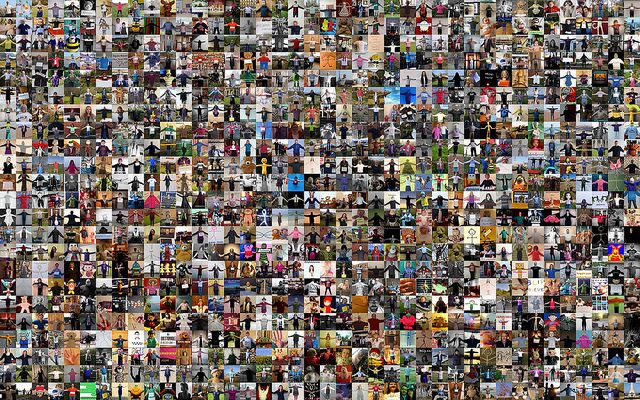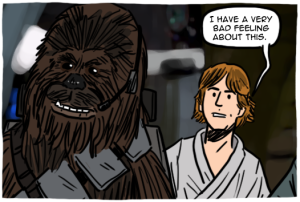See what’s going on with the IU LSGSA.
Archive | Professional Pathways Blog Posts
RSS feed for this sectionAll blog posts syndicated related to Professional Pathways
School of Education gets a new dean!
Oh boy!
Using Twitter with my Students
Communication is Key
I am a big believer in the Flipped Classroom and the focus on “the best use of classroom time” as Jon Bergmann (and many others) describes it.
For my classes and in particular my style of working with my students I find that the time outside of the classroom is equally important. The issue becomes how to keep connected with each other outside.
I’ve used many tools for this over the past 20 years or so:
- Unix talk command
- Usenet news
- Internet Relay Chat (IRC)
- forums in various LMS (Moodle, Blackboard, Schoology)
- good old email
- Facebook (groups and private messages), see my post here
On to Twitter

creative commons licensed (BY) flickr photo by marek.sotak: http://flickr.com/photos/30032901@N04/3275031724
I want the ability for my students to express their ideas and calls for help to the entire class (and course since I usually teach multiple groups) as well as the world at large.
We use a hashtag (#TC1014 and #TC1017 for the courses this semester) to communicate about the class. Students often send me direct messages (DMs) as well but I am trying to encourage them to be more open.
Is it Working?
I tried this in previous semesters and it did not “stick”. I think the reason is that I offered other options like the course LMS and a Facebook group for each course. Now this is the main option and (some) students are using it.
Here is one example, note the communication using images (screenshots) as well as the time stamps here. I can’t be sure but some other students might have learned from this conversation and I used this example of communication in class time to stress the importance of:
- Asking for help is okay.
- Asking in public increases the chances that others will answer.
- Showing details (screenshots or links to code) is important.
@ken_bauer #TC1017 Hi Ken I have a question. I got these functions. both of them gavethe same result. are Both ok? pic.twitter.com/ELEOjuneFt
— Samir (@SamirGL) March 25, 2015
In the one on right, what happens if n1==n2 ? @SamirGL #TC1017
— Ken Bauer (@ken_bauer) March 25, 2015
@ken_bauer I didn't declare that but when I run the program the result is the same number e.g. N1=4 N2=4. The gcm is 4
— Samir (@SamirGL) March 25, 2015
@SamirGL it seems to me that gcd(8,8) will just return nothing…..
— Ken Bauer (@ken_bauer) March 25, 2015
@ken_bauer https://t.co/zUwL25kgFH here's the code. I dont't know why gave me the same number as GCD :/
— Samir (@SamirGL) March 25, 2015
@SamirGL You function is undefined if n1==n2 (compiler warning tells you). pic.twitter.com/I9tYVrRQ6k
— Ken Bauer (@ken_bauer) March 25, 2015
@ken_bauer I got it, thank you. The problem is that my compiler does not warning me of that. pic.twitter.com/lHAZqNScUR
— Samir (@SamirGL) March 25, 2015
Permission before Posting
By-the-way, I asked Samir if I could post this conversation.
@SamirGL Can I use our conversation from yesterday in a blog post?
— Ken Bauer (@ken_bauer) March 27, 2015
@ken_bauer of course teacher
— Samir (@SamirGL) March 27, 2015
@SamirGL Cool. http://t.co/C4mmzMs2l9
— Ken Bauer (@ken_bauer) March 27, 2015
How are you using Twitter?
Your turn now. Is Twitter useful for you with your students or in your professional practice as an educator? Let us know in the comments.
feature image is creative commons licensed (BY-2.0) flickr photo by marek.sotak
Maker Spaces
We’ve been working on a new marker space….
Projects, projectiles, and provocations
I haven’t blogged in a few weeks and time has been slipping through my fingertips. Oh, there’s been plenty on- Many wheels are moving and the way people are coming together to work and make things happen is amazing. Monday I submitted my final (I hope) typescript for my upcoming book: Fostering self-efficacy in higher education students, and that was a major milestone. If all goes to plan, it will be finished and in the pulp (can’t really say in the flesh?) by October. Then there’s the Cello Weekend that I am running in April, with a lovely guest flying over from Chicago, and in May is the big event – the Musiquality ‘Don’t You Quit’ world tour – where the group (5 students + me + our instruments) fly off to California to connect, collaborate, and create with students and teachers from Righetti HS, UCLA, and Cal Poly. That is going to be amazing. (more on that project in a few days)
So I have let writing on the blog slip-
and then on Monday I tuned in to the first #DMLCommons webinar and Alan Levine said something that was an absolute cracker:
‘you don’t get a community with everyone sitting on their front porch talking to themselves.’
He really got me thinking, and he’s right, you know. You don’t get a community when people get too busy to talk to anyone either! Time is a magic thing and I am so hungry to learn. The real problem suddenly dawned on me – with the level of connectedness available through technology it is humanly impossible to keep up. That’s pretty much it. There is just so much to do, so much life to live, and today – so much cake to eat! (fitting in a bake sale in about an hour for the Musiquality project) Maybe it’s like you have to paddle really hard and then you can ride the wave? I’m paddling at the moment and having that vision of the goal is so inspiring.
So we’ve had the projects and the provocation of the quote. What’s the projectile? It’s vaulting ‘us’ into the learning and living experience. For me, in the midst of all these projects I’m singing, playing, baking, hiking, doing, reflecting, learning, and living more in the here and now and doing it all with confidence and real joy. I love the hustle of the cross-continental communication that comes in at all hours and I love the peace of chasing the moon across the sea until it sets – real time, synchronous, asynchronous, connecting with the land, with people, within and without.
I am challenging myself to take Alan’s advice to heart- small and large scale. So if I meet you along one of my journeys, don’t be surprised if I say hello. I may not know you yet, but we may be part of a community soon.
Photo credits: People photo: CC licensed here http://bit.ly/18XirOs ROcker photo CC licensed here: http://bit.ly/1CaMUmg Featured image CC licensed here: http://bit.ly/1N7tt2y
The post Projects, projectiles, and provocations appeared first on lauraritchie.com.
E.T. blog home!
Inspired by the “Connected Brothers” call to action during the first DML Commons webinar yesterday, I have decided to open myself to the…
DML Commons
More tools in the Toolbox
feature image is creative commons licensed (BY-SA) flickr photo by chuckoutrearseats:
My Classroom
I am a transplanted Canadian that has been living and teaching in Zapopan, Jalisco, México for most of the past twenty years at the Tecnológico de Monterrey, Campus Guadalajara.
I have always focused on giving my students broad learning around the content of the course in question as well as pushing them to be active and visible in their academic and social pursuits.
Flipped Learning
Three years ago I was introduce to Flipped Classroom and jumped on that bandwagon not so much to change my classroom but because I felt that this “way of teaching” validated how I already ran my classrooms. The most important part of Flipped Learning for me is the community of educators that I follow and how we can help each other become better at our craft of guiding our students on their learning journeys.

creative commons licensed (BY-SA) flickr photo by chuckoutrearseats: http://flickr.com/photos/48625620@N00/4898356318
Lately I’ve been leading colleagues in their discovery of Flipped Learning as one of many tools in their educator toolbox.
I’m currently offering a course on Flipped Learning in a connected courses format. In the past (and future) I gave courses on blogging with WordPress, tools for formative assessment, tools for writing research (LaTeX, bibliography management), software development and collaboration.
Connected Courses
This leads me to my finding of the connected courses community. As usual I latched onto the ideas of others since I have no problem standing on the shoulders of giants. So my courses have been moved to a connected course system. I happen to be a practicing systems administrator (LAMP in general) so I let to get “under the hood” and control the environment my way.
Why I am Here?
I love expanding my circle of friends and colleagues and especially with those working in domains that I don’t encounter everyday. I hope to share my ideas as well as gain from the ideas of others. Currently I am looking to push my research forward in the area of education (I am a Computer Scientist formally) and am struggling at how to get that area of research kicked off.
Ana Miriam Barragan: From DREAMer to Achiever
Order the Chaos
That is one of the things I am struggling with in #ccourses anyway; what central hub to go to when I get behind and somewhat disoriented. Good thing for me to consider, now that I am considering it, as I hope this exercise helps to sensitize me more to my students who may also feel disoriented at times.When I got quiet, I processed that statement and equated the disorientation with fear of the chaos, the need for order, and I started to reflect on how my understanding of order may be different from other people’s understanding. I think this fear rears it's ugly head when you're learning about technology, and we tend to look at people who "can computer" as being gifted in some way. We think "I could never do that." I’m failing because I am not ordering much of my work in a way that other people can understand. I can’t see where the disconnect is so I’m not sure how to fix it. I think not being able to see is something we struggle with when we're learning about technology, and just like in any other situation it cripples us with frustration. We think "I'm never going to learn this!" I'm failing because I’m not doing well at helping people order their things so that we can link our work together. I think we don't help each other enough. In anything. But that might be another story altogether. I'm failing and it hurts, but at least I’m learning. Now I can push myself to figure out how I have to present things so that people can see the connection, so that they can understand the system. I am not a finisher, but I have to learn how to pull my ideas further. When we're learning, we have to be brave. Learning is chaos, and chaos can be scary, yes, but I think any system can be tamed, ordered, reigned in. I have to learn to order the chaos in my brain better, and be brave enough to keep failing.




